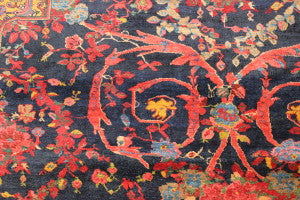A fabulous intermingling of styles, this Persian Bijar was woven 128 years ago as a congratulatory piece. The beautiful center medallion combines gol farangs, or bouquets of foreign flowers, with Mostofi flower patterns. The Mostofi pattern features hypnotically spinning “vines” decorated with a dusting of flowers.

JF5963 - 13’ 3" x 23’ 3"
Wool on cotton, Circa 1890
The Mostofi “vines” are actually an interpretation of the salimi motif. “Salimi” are typically considered snakes by Persian rug weavers. The Chinese originally believed that snakes scared off dragons. This belief developed over time and we often see salimi patterns winding their way around mosque domes. If dragons were flying overhead, they would be deterred by the illusion of snakes slithering across domes or rugs.
In the vines, there is text from an Egyptian poem about Joseph and his father Ayub, representing Ayub’s dream and Joseph coming back home.
The two lozenge shaped panels on either side of the center medallion house two brilliant batons, depicting lions and Shah Abbasi palmettes in the ends.
The brilliant golden field of the rug showcases herati patterns, which are daisies connected by diamonds, typical of Bijar rugs. Mixed together with the mina-khani daisy diamonds are botehs - representative of flames.
 |
 |
The representation of fire in Persian rugs is extremely significant, because over 3000 years ago, people believed that fire was like a God. People believed that fire was significant to life and kept a fire burning at all times - often at the tops of beautiful buildings such as the Qiz Qalesi in present day Turkey.
With this rug’s celebratory inscriptions, we believe it will carry a message of shining warmth and light to its recipient’s home every day.





